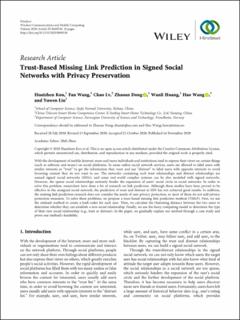| dc.contributor.author | Kou, Huaizhen | |
| dc.contributor.author | Wang, Fan | |
| dc.contributor.author | Lv, Chao | |
| dc.contributor.author | Dong, Zhaoan | |
| dc.contributor.author | Huang, Wanli | |
| dc.contributor.author | Wang, Hao | |
| dc.contributor.author | Liu, Yuwen | |
| dc.date.accessioned | 2021-09-14T07:40:34Z | |
| dc.date.available | 2021-09-14T07:40:34Z | |
| dc.date.created | 2021-03-17T13:24:06Z | |
| dc.date.issued | 2020 | |
| dc.identifier.citation | Wireless Communications & Mobile Computing. 2020, 2020 1-10. | en_US |
| dc.identifier.issn | 1530-8669 | |
| dc.identifier.uri | https://hdl.handle.net/11250/2776359 | |
| dc.description.abstract | With the development of mobile Internet, more and more individuals and institutions tend to express their views on certain things (such as software and music) on social platforms. In some online social network services, users are allowed to label users with similar interests as “trust” to get the information they want and use “distrust” to label users with opposite interests to avoid browsing content they do not want to see. The networks containing such trust relationships and distrust relationships are named signed social networks (SSNs), and some real-world complex systems can be also modeled with signed networks. However, the sparse social relationships seriously hinder the expansion of users’ social circle in social networks. In order to solve this problem, researchers have done a lot of research on link prediction. Although these studies have been proved to be effective in the unsigned social network, the prediction of trust and distrust in SSN has not achieved good results. In addition, the existing link prediction research does not consider the needs of user privacy protection, so most of them do not add privacy protection measures. To solve these problems, we propose a trust-based missing link prediction method (TMLP). First, we use the simhash method to create a hash index for each user. Then, we calculate the Hamming distance between the two users to determine whether they can establish a new social relationship. Finally, we use the fuzzy computing model to determine the type of their new social relationship (e.g., trust or distrust). In the paper, we gradually explain our method through a case study and prove our method’s feasibility. | en_US |
| dc.language.iso | eng | en_US |
| dc.publisher | Hindawi | en_US |
| dc.rights | Navngivelse 4.0 Internasjonal | * |
| dc.rights.uri | http://creativecommons.org/licenses/by/4.0/deed.no | * |
| dc.title | Trust-Based Missing Link Prediction in Signed Social Networks with Privacy Preservation | en_US |
| dc.type | Peer reviewed | en_US |
| dc.type | Journal article | en_US |
| dc.description.version | publishedVersion | en_US |
| dc.source.pagenumber | 1-10 | en_US |
| dc.source.volume | 2020 | en_US |
| dc.source.journal | Wireless Communications & Mobile Computing | en_US |
| dc.identifier.doi | 10.1155/2020/8849536 | |
| dc.identifier.cristin | 1898645 | |
| dc.description.localcode | Copyright © 2020 Huaizhen Kou et al. This is an open access article distributed under the Creative Commons Attribution License, which permits unrestricted use, distribution, and reproduction in any medium, provided the original work is properly cited. | en_US |
| cristin.ispublished | true | |
| cristin.fulltext | original | |
| cristin.qualitycode | 1 | |

